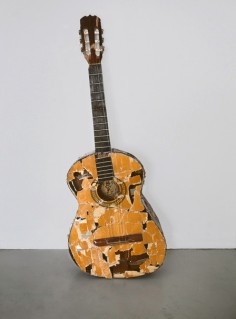Sofia Hultén
Fuck It Up and Start Again
source: raebervonstenglin
Sofia Hultén was born in 1972 in Sweden. She lives and works in Berlin. Her recent solo exhibitions include ‘If You Never Did You Should’, Konrad Fischer Galerie, Berlin (2013); ‘How did it get so late so soon’, Kunstverein Braunschweig, Braunschweig (2013); ‘Sofia Hultén and Nina Canell’, Galeria Luisa Strina, São Paulo, Brazil (2013); ‘Statik Elastik’, Langen Foundation, Neuss, Germany (2012); ‘One in Ten’, Galerie Nordenhake,Stockholm, Sweden (2012); ‘Moderna Museets Vänners Skulpturpris 2011′, Moderna Museet, Stockholm, Sweden (2011) and ‘PRESSURE DROP’, RaebervonStenglin, Zurich, Switzerland (2011).
.
.
.
.
.
.
source: initiartmagazine
Studied sculpture in the UK in early 1990s, Sofia Hultén (*1972, Stockholm) has been influenced by the idea of sculpture as an expandable media with a performative potential. Instead of producing objects, Sofia is interested in changing the state of existence of her ready-made material. Her work is therefore four dimensional where time becomes an intelligible element. What’s important to her is not to reach the final destination – object of art – through the shortest route, but to circle around in the labyrinth of possibilities which is to her, a process of unpredictability.
.
.
.
.
.
.
source: frieze-magazinde
Sofia Hultén finds the material for her works on the street. She alters the ordinary course of events with subtle gestures, usually documented on video. It would be tempting to call her approach ‘urban intervention’, were it not for the minimalism of her actions. For the early work Getting Rid of Stuff (2001), she took various objects from a gallery storage room and elegantly made them disappear in the city (for example, a garden hose vanished down a sewer hole). For Auflösung (Dissolution, 2008) – a project about vacant lots in Berlin – she took objects she found in the lots, like an old mattress, and put them through a shredder before returning them to their original location.
The anarchic impetus in Hultén’s work could be felt in the exhibition Statik Elastik (Static Elastic) at the Langen Foundation. This private institution – which opened in 2004 on the site of a former NATO missile base – was designed by the architect Tadao Andoˉ. The refined building in steel, glass and concrete created a rigid framework for Hultén’s clearly structured presentation of six works produced between 2010 and 2012. Andoˉ’s ‘Room of Silence’ – originally used for the Japanese acquisitions of Viktor und Marianne Langen’s collection – appears as a hermetically sealed space, to which Hultén responded in various ways. By foregoing plinths and other common display elements, she mirrored the surrounding minimal architecture; monitors and other exhibits were simply left standing or lying on the floor. In spite of the heterogeneity of her works, this presentation gave the show the coherence of an austere whole. In contrast, three pillars made of stacked car jacks – the titular Statik Elastik (2012) – looked like an attempt to break through this sense of closure and raise the roof a few inches.
Nevertheless, what emerged clearly was the meditative dimension of Hultén’s work. In the video loop 4-D (2012), a found piece of wood is given the same treatment over and over again: cut, sprayed, thrown into a puddle and scraped against the edge of a wall. The artist pays great attention to seemingly minor details and uses found materials frugally. The 72-minute video Past Particles (2010) shows items from an overflowing toolbox – a bent nail, a screw, a rusty nut or a bolt – as if they were on a miniature stage. The video projection Immovable Object / Unstoppable Force (2012) filled the exhibition space’s end wall and provided the finale. We see the artist using telekinesis – patiently, silently – to try to move containers filled with rubble on Berlin streets. However humorous, this work addresses the mental distress caused by construction sites. Or perhaps Hultén is attempting to construct her own psycho-buildings: made with thoughts instead of bricks.
.
.
.
.
.
.
.
source: modernamuseetse
I sin konst förenar Sofia Hultén den gravallvarligt direkta estetiken i instruktionsfilmer av den typ som görs av byggvaruhuset Bauhaus med en befriande absurd humor. I ett slags vardagliga performancer genomförs olika till synes resultatlösa sysslor med en självpåtagen rituell metodik.
Verken utgår från en meningsbärande bakgrund som förenar så disparata ämnen som kriminologi, science fiction och kvantfysik. Hulténs filosofiska undersökningar upprättar innehållsliga förbindelser mellan individen och kollektivet, universums oändliga utvidgning och den kompakta massan hos svarta hål, uttryckt i metaforisk form genom dessa triviala försök att påverka framtiden.
De tunna trälisterna i If you want to hide a tree, go to the forest (2010) är både nytillverkade av konstnären och readymades. Vilka som är kopior och vilka som är original är inte längre möjligt att avgöra. Med ett kärleksfullt vårdande av tingens integritet blandas fakta och fiktion på ett märkvärdigt sätt. Försvinnandets existentiella problematik är ett återkommande tema i Sofia Hulténs konst. Verket är en variant av hennes cykliska processarbeten där hon aktiverar skillnaden mellan det använda och det förbrukade. Tidigare har hon renoverat objekt som hon hittat för att sedan återställa dem till deras slitna ursprungsskick. Trots den skulpturala avbildningens naturtrogna utseende har något ändå förändrats i grunden. Hennes rekonstruktioner arbetar med flera parallella tidsriktningar i ett ifrågasättande av status quo.


